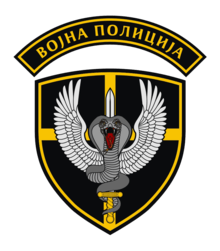Cobras (Serbia)
The Cobras (Serbian: Kobre / Кобрe) is a military police unit of the Serbian Armed Forces, responsible for counter-terrorism, close protection and special operations. The unit consists of one battalion and 200 members (as of 2013) and is notably responsible for protection of military officials and the President.[3] It is one of several special forces of Serbia, and the oldest anti-terrorist unit in former Yugoslavia.
| Battalion of the Military Police for Special Operations "Cobras" (Serbian: Батаљон војне полиције специјалне намене „Кобре“)[1][2] | |
|---|---|
| Батаљон војне полиције специјалне намене „Кобре“ | |
 Emblem of Military Police Battalion Cobra | |
| Active | 14 April 1978 – present |
| Country | |
| Role | Special Forces Military Police |
| Size | 200 (2013) |
| Garrison/HQ | Belgrade |
| Colors | Black, yellow |
| Commanders | |
| Current commander | Lt colonel Vladimir Ušljebrka |
The unit was first established by the order of the Secretary of Defense on 14 April 1978. The unit was included in a special 'anti-terrorist department' (Odeljenje Vojne policije za protivteroristička dejstva) within the 282nd battalion of the Yugoslav People's Army (JNA). In 1985 the department expanded and transformed into a 'anti-terrorist platoon' (Vod za protivteroristička dejstva) which led the Guard Brigades. It continued to exist after the breakup of Yugoslavia as a special unit of the FR Yugoslav/Serbia and Montenegro Armed Forces (1992–2006). It was active in the Yugoslav Wars. In 1992 it was transferred to the Special Units Corps (Korpus specijalnih jedinica), which included the 63rd Parachute Battalion, 72nd Assault Battalion and 1st Guard Brigade. In 2000 the unit was placed under the direct command of the Chief of General Staff. The unit further expanded, much thanks to colonel (pukovnik) Stojan Kljajić who commanded the unit until 2005. In this period the symbol of a winged cobra twisted around a sword was adopted. It was organized as an anti-terrorist detachment until 2006, when it became the present-day battalion, since a component of the Serbian military police.
See also
- Special Brigade
- List of military special forces units
References
- "Посета Батаљону војне полиције специјалне намене „Кобре"". Vojska Srbije. Archived from the original on 2018-04-12. Retrieved 2018-04-12.
- "Кобре – најстарија противтерористичка јединица". mod.gov.rs. Government of Serbia.
- Military Police Battalion of the Army of Serbia – Cobra Archived 2015-03-22 at the Wayback Machine
External links
- Military Police Battalion Cobra at specijalne-jedinice.com (in Serbian)
- VSCG SPECIAL FORCES